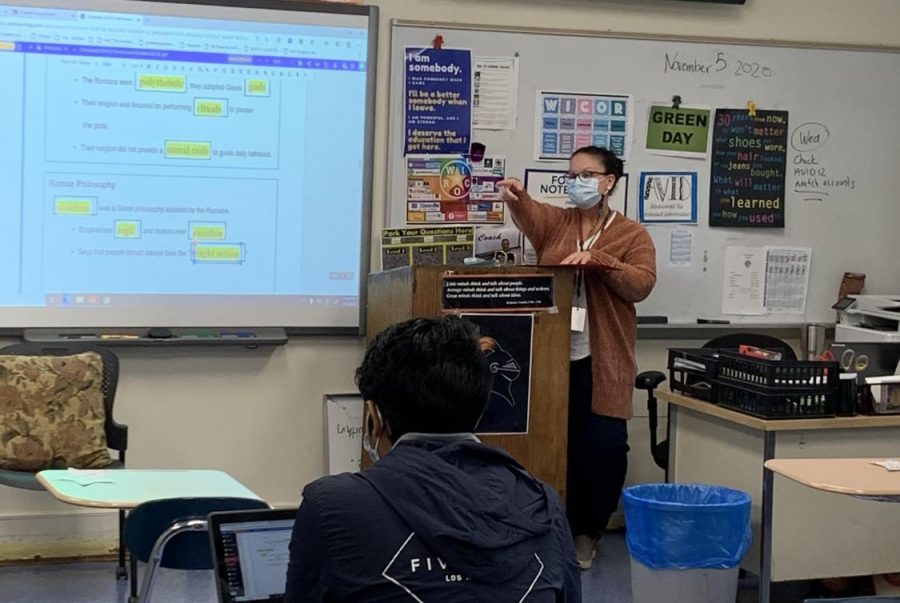Are ESL Students Receiving the Help They Need During the Pandemic?
Why Stamford Public Schools’ assistance to ESL students in the Distance Learning Academy may not be enough.
DLTA tutor Gina Figluizzi says that despite the districts best efforts, the language barrier makes it difficult to offer the same level of service through distance learning.
November 5, 2020
The Coronavirus outbreak has made school very challenging for all students. Along with following safety guidelines, students must learn a full year’s worth of material given half of the in-school learning opportunities. Despite these challenges, many students have still been able to learn in their classes.
The district has removed time-consuming midterms and finals from the curriculum to accommodate these new circumstances. To ensure that students feel comfortable learning during the pandemic, they have also offered a Distanced Teaching and Learning Academy (DTLA), a fully remote option. Although the district has made efforts to adjust to these unforeseen circumstances, students who speak English as a second language have still been met with great obstacles while adjusting to new learning conditions.
There are several examples of the district struggling to accommodate ESL students. For example, the Stamford Public Schools (SPS) website states that sheltered courses taught specifically for ESL students are offered in all content areas such as sheltered English, history, math, and science. However, the students learning through DTLA do not receive the same learning opportunities, as the only sheltered classes offered have been Sheltered Geometry and Sheltered Algebra.
Many students enrolled in DTLA were put in College Preparatory (CP) English. This class is taught entirely in English, and it has no built-in accommodations for non-English-speaking students. ESL students initially attended a month of CP English in this way. Recently, however, SPS made some additional accommodations. The school has now assigned teachers to provide tutoring to students to ensure that they understand the material. While this may sound like it has solved the problem, some of these assigned teachers don’t believe the district is doing enough.
Social Studies teacher and assigned ESL tutor Gina Figliuzzi said, “I feel that we are trying to reach these students every way we know how, but the language barriers are still preventing us from really being able to help them. They aren’t fluent in English, and we aren’t necessarily fluent in their language.” Teachers cannot communicate effectively with their students without using Google Translate or a similar tool, an inefficient way to provide a productive learning environment.
Aside from practical problems, there may be legal issues with how the school is solving these problems. According to CT.gov’s Bilingual Education Program Overview, “each child shall have for the period prescribed in the general statutes equal opportunity to receive a suitable program of educational experiences.” Stamford High’s solution may not comply with this, as learning through Google Translate isn’t necessarily “suitable.”
Another potential legal concern is raised by the State of Connecticut’s Department of Education Website. It states that the school must assist English-Language Learner students in “developing speaking proficiency and literacy in English and in mastering the same academic content required of all other students, e.g., language arts, literature, mathematics, science, and social studies.” The DTLA ESL students aren’t given the opportunity to master the same academic content because they aren’t being taught in the language they understand best, and they aren’t offered enough sheltered classes.
Though teaching bilingually isn’t a requirement, offering sheltered instruction is required if bilingual education isn’t provided. Regarding that distinction, CT.gov explains that in a sheltered class, “Teachers commonly use such contextual clues as pictures, manipulates, body language and gestures, and hands-on teaching activities to make what they are teaching understandable to students who are concurrently in the process of acquiring English as a second or additional language.” These efforts don’t occur in virtual classrooms as they are classes with English speaking students as well.
Ann R. Smith, Executive Director of the advocacy and education group AFCAMP Advocacy for Children, explained, “there are categories of students for whom distance learning is not effectively meeting their education needs.” This includes English language learners and students with disabilities. She added that “overcoming barriers to sheltered instruction and special education services requires that Connecticut state and local education agencies join with families, students, school personnel, and community stakeholders to ensure investment in resources and adoption of effective policy and practice changes that foster equitable educational outcomes for all students.”
While school resources are limited and spread thinly, the district needs to ensure that all students, regardless of their native language, receive equal learning opportunities as native English speakers.





